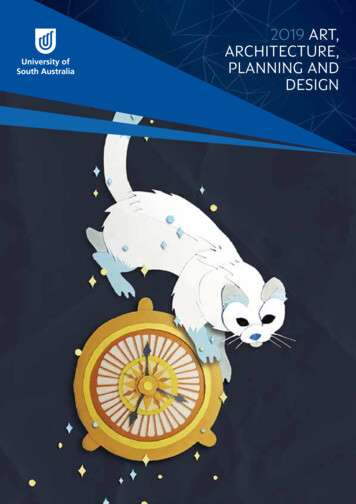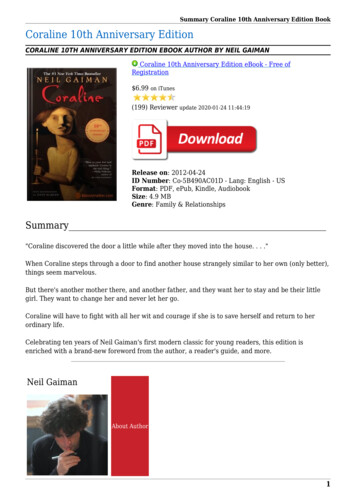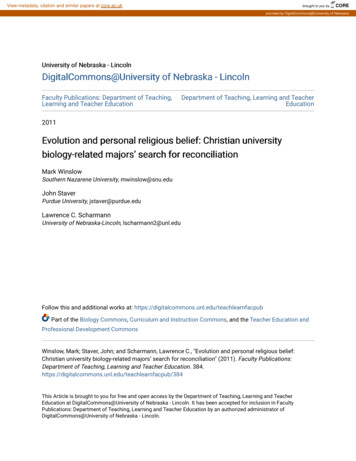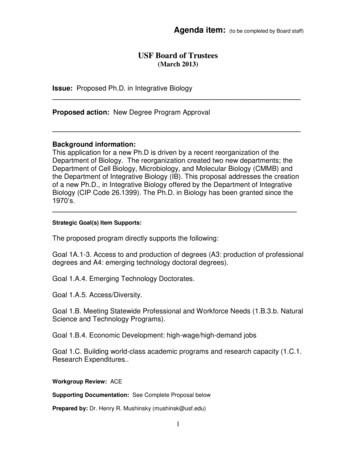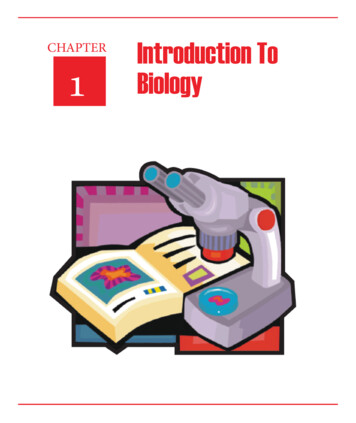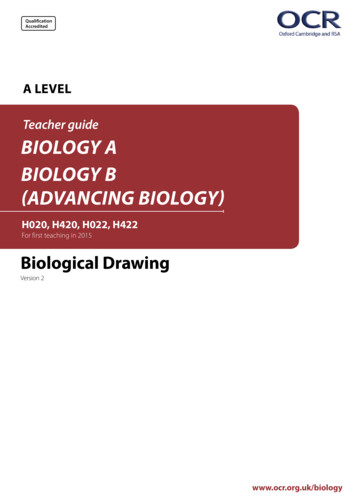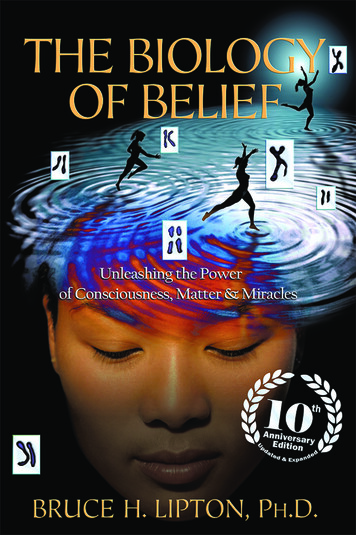
Transcription
Praise for The Biology of Belief“Bruce Lipton’s book is the definitive summary of the new biologyand all it implies. It is magnificent, profound beyond words, and adelight to read. It synthesizes an encyclopedia of critical new information into a brilliant yet simple package. These pages contain agenuine revolution in thought and understanding, one so radicalthat it can change the world.”— Joseph Chilton Pearce, Ph.D.,author of Magical Child and Evolution’s End“Bruce Lipton’s delightfully written The Biology of Belief is a muchneeded antidote to the ‘bottom-up’ materialism of today’s society.The idea that DNA encodes all of life’s development is being successfully employed in genetic engineering. At the same time, theshortfall of this approach is becoming evident. The Biology of Beliefis a review of a quarter-century of pioneering results in Epigenetics,heralded by The Wall Street Science Journal in mid-2004 as an important new field. Its personal style makes it eminently readable andenjoyable.”— Karl H. Pribram, M.D., Ph.D.,(Hon. Multi), professor emeritus, Stanford University“Dr. Lipton is a genius. His breakthrough discoveries give us toolsfor regaining the sovereignty over our lives. I recommend this bookto anyone who is ready and willing to take full responsibility forthemselves and the destiny of our planet.”— LeVar Burton, actor and director“Bruce Lipton offers new insights and understanding into theinterface between biological organisms, the environment—and theinfluence of thought, perception, and subconscious awareness—onthe expression of one’s body healing potential. Well-referencedexplanations and examples make this book a refreshing ‘must read’for the student of the biological, social, and health care sciences.
Yet the clarity of the author’s presentation makes it an enjoyableread for a general audience.”— Carl Cleveland III, D.C.,President, Cleveland Chiropractic College“Dr. Lipton’s revolutionary research has uncovered the missingconnections between biology, psychology, and spirituality. If youwant to understand the deepest mysteries of life, this is one of themost important books you will ever read.”—Dennis Perman, D.C., co-founder, The Master’s Circle“In this paradigm-busting book, Bruce Lipton delivers a TKO to OldBiology. With a left to Darwinian dogma and a right to allopathicmedicine, he breaks out of the physicalist box into enlightenmenton the mind/body (belief/biology) system. Must read, much fun.”— Ralph Abraham, Ph.D., professor of mathematics,University of California; author of Chaos, Gaia, Eros“Powerful! Elegant! Simple! In a style that is as accessible as it ismeaningful, Dr. Bruce Lipton offers nothing less than the longsought–after ‘missing link’ between life and consciousness. Indoing so, he answers the oldest questions and solves the deepestmysteries of our past. I have no doubt that The Biology of Belief willbecome a cornerstone for the science of the new millennium.”— Gregg Braden,best-selling author of The God Code and The Divine Matrix“I finished reading this book with the same sense of profoundrespect I have when I am with Bruce Lipton—that I have beentouched by a revolutionary sense of the truth. He is both a scientistand a philosopher; a scientist in that he provides us with tools toalter cultural consciousness and a philosopher because he challenges our beliefs about the very nature of our perceived reality.He is helping us create our own futures.”— Guy F. Riekeman, D.C.,President, Life University and College of Chiropractic
“The Biology of Belief is a milestone for evolving humanity. Dr. BruceLipton has provided, through his amazing research and in thisinspiring book, a new, more awakened science of human growth andtransformation. Instead of being limited by the genetic or biologicalconstraints that humanity has been programmed to live by, humanity now has before it a way of unleashing its true spiritual potentialwith the help of simply transformed beliefs guided by ‘the gentleand loving hand of God.’ A definite must read for those dedicatedto the mind/body movement and to the true essence of healing.”— Dr. John F. Demartini, best-selling author ofCount Your Blessings and The Breakthrough Experience“In a world of chaos, Dr. Lipton brings clarity to mankind. His work isthought-provoking, insightful, and will hopefully lead people to askbetter quality questions in their lives and to make better decisions.One of the most exciting books I have read, this is a must read.”— Brian Kelly, D.C., President, New Zealand College ofChiropractic; President, Australian Spinal Research Foundation“Finally, a compelling and easy-to-understand explanation of howyour emotions regulate your genetic expression! You need to readthis book to truly appreciate that you are not a victim of your genesbut instead have unlimited capacity to live a life overflowing withpeace, happiness, and love.”— Joseph Mercola, D.O., Founder ofwww.mercola.com, world’s most visited natural-health site“This book is an absolute must read if you want to know, from ascientific viewpoint, that your lifestyle is in control of your healthrather than your genetics. From a scientific viewpoint, Liptondemonstrates that the mind is more powerful than drugs to regainour health. The information reveals that your health is more yourresponsibility than just being a victim of your genes. When Istarted reading this book, I could not stop until it was finished.”— M. T. Morter, Jr., D.C.,founder, Morter Health System;developer of the B.E.S.T. Technique
“This is a courageous and visionary book that provides solid evidence from quantum biology to dispel the myth of genetic determinism—and implicitly, victimhood. Dr. Bruce Lipton brings a solidscientific mind to not only inform but to transform and empowerthe reader with the realization that our beliefs create every aspect ofour personal reality. A provocative and inspiring read!”— Lee Pulos, Ph.D., A.B.P.P.,professor emeritus, University of British Columbia;author of Miracles and Other Realities and Beyond Hypnosis“History will record The Biology of Belief as one of the most important writings of our time. Bruce Lipton has delivered the missing link between the understandings of biomedicine of the pastand the essentials of energetic healing of the future. His complexinsights are expressed in a readily understandable fashion witha style that welcomes the scientist and the nonscientist on anequal footing. For anyone interested in health, the well-being ofthe species, and the future of human life, The Biology of Belief is amust read. The implications of the perspectives outlined have thepotential to change the world as we know it. Bruce Lipton’s understandings—and his concise expression of them—are sheer genius.”— Gerard W. Clum, D.C.,President, Life Chiropractic College West
THE BIOLOGY OF BELIEFUnleashing the Power of Consciousness,Matter & MiraclesBruce H. Lipton, Ph.D.HAY HOUSE, INC.Carlsbad, California New York CityLondon Sydney JohannesburgVancouver Hong Kong New Delhi
Copyright 2005 by Bruce LiptonRevised Copyright 2008 by Mountain of Love ProductionsUpdated Copyright 2015 by Mountain of Love ProductionsPublished and distributed in the United States by: Hay House, Inc.: www.hayhouse.com Published and distributed in Australia by: Hay House AustraliaPty. Ltd.: www.hayhouse.com.au Published and distributed in the United Kingdom by: Hay House UK, Ltd.: www.hayhouse.co.uk Published and distributedin the Republic of South Africa by: Hay House SA (Pty), Ltd.: www.hayhouse.co.za Distributed in Canada by: Raincoast Books: www.raincoast.com Published inIndia by: Hay House Publishers India: www.hayhouse.co.inIndexer: Susan EdwardsCover design: 2004 Robert MuellerInterior design: Nick C. WelchAll rights reserved. No part of this book may be reproduced by any mechanical, photographic, or electronic process, or in the form of a phonographic recording; nor may it be stored in a retrieval system, transmitted, or otherwise be copiedfor public or private use—other than for “fair use” as brief quotations embodied inarticles and reviews—without prior written permission of the publisher.The author of this book does not dispense medical advice or prescribe the useof any technique as a form of treatment for physical, emotional, or medical problems without the advice of a physician, either directly or indirectly. The intent ofthe author is only to offer information of a general nature to help you in your questfor emotional and spiritual well-being. In the event you use any of the informationin this book for yourself, the author and the publisher assume no responsibility foryour actions.Library of Congress Cataloging-in-Publication DataLipton, Bruce H.The biology of belief : unleashing the power of consciousness, matter & miracles/ Bruce H. Lipton, Ph.D. -- 10th anniversary edition.pages cmIncludes bibliographical references and index.ISBN 978-1-4019-4891-7 (hardcover : alk. paper) 1. Cytology. 2. Molecular biology. 3. Genetic psychology. 4. Psychophysics. I. Title.QH581.2.L56 2015599.93’5--dc232015010850Hardcover ISBN: 978-1-4019-4891-710 9 8 7 6 5 4 3 2 11st edition, October 2015Printed in the United States of America
This book is dedicated to . . .The Mother of Us AllMay She forgive us our trespasses.To my own mother, Gladys,who has continually encouraged and supported mewhile being patient for the twenty yearsit took to get this book out.To my daughters, Tanya and Jennifer,beautiful women of the world who have always been therefor me . . . no matter how weird things had become.And especially to my darling, Margaret Horton,my best friend, my life partner, my love.May we continue on our joyous questto live happily ever after!
ContentsPrologue . . . . . . . . . . . . . . . . . . . . . . . . . . . . . . . . . . xiiiIntroduction . . . . . . . . . . . . . . . . . . . . . . . . . . . . . . . . xviiChapter 1:Lessons from the Petri Dish: In Praise ofSmart Cells and Smart Students . . . . . . . . . . . . . . . 1Chapter 2:It’s the Environment, Stupid . . . . . . . . . . . . . . . . 25Chapter 3:The Magical Membrane . . . . . . . . . . . . . . . . . . 57Chapter 4:The New Physics: Planting Both FeetFirmly on Thin Air . . . . . . . . . . . . . . . . . . . . . 83Chapter 5:Biology and Belief . . . . . . . . . . . . . . . . . . . . . 117Chapter 6:Growth and Protection . . . . . . . . . . . . . . . . . . 149Chapter 7:Conscious Parenting: Parents as Genetic Engineers . . .165Epilogue:Spirit and Science . . . . . . . . . . . . . . . . . . . . . 201Addendum . . . . . . . . . . . . . . . . . . . . . . . . . . . . . . . . .229Acknowledgments . . . . . . . . . . . . . . . . . . . . . . . . . . . . .235Endnotes . . . . . . . . . . . . . . . . . . . . . . . . . . . . . . . . . .241Index . . . . . . . . . . . . . . . . . . . . . . . . . . . . . . . . . . . .259About the Author . . . . . . . . . . . . . . . . . . . . . . . . . . . . . .277
Chap ter 1LESSONS from the PETRI DISH:In Praise of Smart Cells and Smart StudentsOn my second day in the Caribbean, as I stood in front of morethan a hundred visibly on-edge medical students, I suddenlyrealized that not everyone viewed the island as a laid-back refuge.For these nervous students, Montserrat was not a peaceful escapebut a last-ditch chance to realize their dreams of becoming doctors.My class was geographically homogeneous, mostly Americanstudents from the East Coast, but there were all races and ages,including a sixty-seven-year-old retiree who was anxious to domore with his life. Their backgrounds were equally varied—formerelementary school teachers, accountants, musicians, a nun, andeven a drug smuggler.Despite all the differences, the students shared two characteristics: One, they had failed to succeed in the highly competitiveselection process that filled the limited number of positions inAmerican medical schools. Two, they were “strivers” intent onbecoming doctors—they were not about to be denied the opportunity to prove their qualifications. Most had spent their life savingsor indentured themselves to cover the tuition and extra costs ofliving out of the country. Many found themselves completely alonefor the first time in their lives, having left their families, friends,and loved ones behind. They put up with the most intolerableliving conditions on that campus. Yet with all the drawbacks andthe odds stacked against them, they were never deterred from theirquest for a medical degree.
The Biology of BeliefWell, at least that was true up to the time of our first classtogether. Prior to my arrival, the students had had three differenthistology/cell biology professors. The first lecturer left the studentsin the lurch when he responded to some personal issue by boltingfrom the island three weeks into the semester. In short order, theschool found a suitable replacement who tried to pick up the pieces;unfortunately he bailed three weeks later because he got sick. Forthe preceding two weeks, a faculty member, responsible for anotherfield of study, had been reading chapters out of a textbook to theclass. This obviously bored the students to death, but the schoolwas fulfilling a directive to provide a specified number of lecturehours for the course. Academic prerequisites set by American medical examiners have to be met in order for the school’s graduates topractice in the States.For the fourth time that semester, the weary students listened toa new professor. I briefed them on my background and my expectations for the course. I made it clear that even though we were in aforeign country, I was not going to expect any less from them thanwhat was expected from my Wisconsin students. Nor should theywant me to because to be certified all doctors have to pass the sameMedical Boards, no matter where they go to medical school. ThenI pulled a sheaf of exams out of my briefcase and told the studentsthat I was giving them a self-assessment quiz. The middle of thesemester had just passed, and I expected them to be familiar withhalf of the required course material. The test I handed out on thatfirst day of the course consisted of twenty questions taken directlyfrom the University of Wisconsin histology midterm exam.The classroom was deadly silent for the first ten minutes of thetesting period. Then nervous fidgeting felled the students one byone, faster than the spread of the deadly Ebola virus. By the timethe twenty minutes allotted for the quiz were over, wide-eyed panichad gripped the class. When I said, “Stop,” the pent-up nervousanxiety erupted into the din of a hundred excited conversations.I quieted the class down and began to read them the answers.The first five or six answers were met with subdued sighs. After Ireached the tenth question, each subsequent answer was followed2
Lessons from the Petri Dishby agonizing groans. The highest score in the class was ten correctanswers, followed by several students who answered seven correctly; with guesswork, most of the rest scored at least one or twocorrect answers.When I looked up at the class, I was greeted with frozen,shell-shocked faces. The “strivers” found themselves behind thebig eight ball. With more than half a semester behind them, theyhad to start the course all over again. A dark gloom overcame thestudents, most of whom were already treading water in their other,very demanding medical school courses. Within moments, theirgloom had turned into quiet despair. In profound silence, I lookedout over the students and they looked back at me. I experiencedan internal ache—the class collectively resembled one of thoseGreenpeace pictures of wide-eyed baby seals just before heartlessfur traders club them to death.My heart welled. Perhaps the salt air and sweet scents hadalready made me more magnanimous. In any case, unexpectedly,I found myself announcing that I would make it my personal commitment to see that every student was fully prepared for the finalexam, if they would commit to providing matching efforts. Whenthey realized I was truly committed to their success, I could see thelights flash on in their previously panicked eyes.Feeling like an embattled coach revving up the team for the BigGame, I told them I thought they were every bit as intelligent as thestudents I taught in the States. I told them I believed their statesidepeers were simply more proficient at rote memorization, the qualitythat enabled them to score better in the medical college admissionstests. I also tried very hard to convince them that histology andcell biology are not intellectually difficult courses. I explained thatin all of its elegance, nature employs very simple operating principles. Rather than just memorizing facts and figures, I promisedthey were going to gain an understanding of cells because I wouldpresent simple principles on top of simple principles. I offered toprovide additional night lectures, which would tax their staminaafter their already long lecture- and lab-packed days. The studentswere pumped up after my ten-minute pep talk. When the period3
The Biology of Beliefended, they bolted from that classroom snorting fire, determinedthey would not be beaten by the system.After the students left, the enormity of the commitment I hadmade sank in. I started having doubts. I knew that a significantnumber of the students were truly unqualified to be attendingmedical school. Many others were capable students whose backgrounds had not prepared them for the challenge. I was afraid thatmy island idyll would degenerate into a frenetic, time-consumingacademic scrimmage that would end in failure for my students andfor me as their teacher. I started thinking about my job at Wisconsin, and suddenly it was beginning to look easy. At Wisconsin, Igave only eight lectures out of the approximately fifty that madeup the histology/cell biology course. There were five members ofthe anatomy department who shared the lecturing load. Of courseI was responsible for the material in all of the lectures because I wasinvolved in their accompanying laboratory sessions. I was supposedto be available to answer all course-related questions asked by thestudents. But knowing the material and presenting lectures on thematerial are not the same thing!I had a three-day weekend to wrestle with the situation I hadcreated for myself. Had I faced a crisis such as this back home, mytype A personality would have had me swinging from the proverbial chandeliers. Interestingly, as I sat by the pool, watching thesun set into the Caribbean, the potential angst simply morphedinto an exciting adventure. I began to get excited about the factthat for the first time in my teaching career, I was solely responsiblefor this major course and free from having to conform to the styleand content restrictions of team-taught programs.Cells as Miniature HumansAs it turned out, that histology course was the most exhilarating and intellectually profound period of my academic career. Freeto teach the course the way I wanted to teach it, I ventured into anew way of covering the material, an approach that had been roiling in my brain for several years. I had been fascinated by the idea4
Lessons from the Petri Dishthat considering cells as “miniature humans” would make it easierto understand their physiology and behavior. As I contemplated anew structure for the course, I got excited. The idea of overlappingcell and human biology rekindled the inspiration for science I hadfelt as a child. I still experienced that enthusiasm in my researchlaboratory, though not when I was mired in the administrativedetails of being a tenured faculty member, including endless meetings and what, for me, were torturous faculty parties.I was prone to thinking of cells as human-like because, afteryears behind a microscope, I had become humbled by the complexity and power of what at first appear to be anatomically simple,moving blobs in a petri dish. In school you may have learned thebasic components of a cell: the nucleus that contains genetic material, the energy-producing mitochondria, the protective membraneat the outside rim, and the cytoplasm in between. But within theseanatomically simple–looking cells is a complex world; these smartcells employ technologies that scientists have yet to fully fathom.The notion of cells as miniature humans that I was mullingover would be considered heresy by most biologists. Trying toexplain the nature of anything not human by relating it to humanbehavior is called anthropomorphism. “True” scientists consideranthropomorphism to be something of a mortal sin and ostracizescientists who knowingly employ it in their work.However, I believed that I was breaking out of orthodoxy fora good reason. Biologists try to gain scientific understanding byobserving nature and conjuring up a hypothesis of how thingswork. Then they design experiments to test their ideas. By necessity, deriving the hypothesis and designing the experiments requirethe scientist to “think” how a cell or another living organism carries out its life. Applying these “human” solutions, i.e., a humanview of resolving biology’s mysteries, automatically makes thesescientists guilty of anthropomorphizing. No matter how you cutit, biological science is based to some degree on humanizing thesubject matter.Actually, I believe that the unwritten ban on anthropomorphismis an outmoded remnant of the Dark Ages, when religious authorities5
The Biology of Beliefdenied any direct relationship existed between humans and anyof God’s other creations. While I can see the value of the conceptwhen people try to anthropomorphize a lightbulb, a radio, or apocketknife, I do not see it as a valid criticism when it is applied toliving organisms. Human beings are multicellular organisms—wemust inherently share basic behavioral patterns with our own cells.However, I know that it takes a shift in perception to acknowledge that parallel. Historically, our Judeo-Christian beliefs have ledus to think that we are the intelligent creatures who were created ina separate and distinct process from all other plants and animals.This view has us looking down our noses at lesser creatures asnonintelligent life forms, especially those organisms on the lowerevolutionary rungs of life.Nothing could be further from the truth. When we observeother humans as individual entities or see ourselves in the mirror asan individual organism, in one sense, we are correct, at least fromthe perspective of our level of observation. However, if I broughtyou down to the size of an individual cell so you could see yourbody from that perspective, it would offer a whole new view of theworld. When you looked back at yourself from that perspective youwould not see yourself as a single entity. You would see yourself asa bustling community of more than 50 trillion individual cells.As I toyed with these ideas for my histology class, the picturethat kept recurring in my mind was a chart from an encyclopediaI had used as a child. Under the section on humans, there wasan illustration with seven transparent plastic pages, each printedwith an identical, overlapping outline of the human body. On thefirst page the outline was filled in with an image of a naked man.Turning the first page was like peeling off his skin and revealinghis musculature, the image within the outline on the second page.When I turned the second page, the overlapping images of theremaining pages revealed a vivid dissection of the body. Flippingthrough the pages I could see in turn, the skeleton, the brain andnerves, blood vessels, and organ systems.For my Caribbean course, I mentally updated those transparencies with several additional, overlapping pages, each illustrated6
Lessons from the Petri Dishwith cellular structures. Most of the cell’s structures are referred toas organelles, which are its “miniature organs” suspended withina jelly-like cytoplasm. Organelles are the functional equivalents ofthe tissues and organs of our own bodies. They include the nucleus,which is the largest organelle, the mitochondria, the Golgi body,and vacuoles. The traditional way of teaching the course is to dealfirst with these cellular structures, then move on to the tissues andorgans of the human body. Instead, I integrated the two parts ofthe course to reflect the overlapping nature of humans and cells.I taught my students that the biochemical mechanismsemployed by cellular organelle systems are essentially the samemechanisms employed by our human organ systems. Even thoughhumans are made up of trillions of cells, I stressed that there is notone “new” function in our bodies that is not already expressed inthe single cell. Virtually every eukaryote (nucleus-containing cell)possesses the functional equivalent of our nervous system, digestive system, respiratory system, excretory system, endocrine system, muscle and skeletal systems, circulatory system, integument(skin), reproductive system, and even a primitive immune system,which utilizes a family of antibody-like “ubiquitin” proteins.I also made it clear to my students that each cell is an intelligentbeing that can survive on its own, as scientists demonstrate whenthey remove individual cells from the body and grow them in aculture. As I knew intuitively when I was a child, these smart cellsare imbued with intent and purpose; they actively seek environments that support their survival while simultaneously avoidingtoxic or hostile ones. Like humans, single cells analyze thousandsof stimuli from the microenvironment they inhabit. Through theanalysis of this data, cells select appropriate behavioral responsesto ensure their survival.Single cells are also capable of learning through these environmental experiences and are able to create cellular memories, whichthey pass on to their offspring. For example, when a measles virusinfects a child, an immature immune cell is called in to create aprotective protein antibody against that virus. In the process, thecell must create a new gene to serve as a blueprint in manufacturing the measles antibody protein.7
The Biology of BeliefThe first step in generating a specific measles antibody geneoccurs in the nuclei of immature immune cells. Among their genesare a very large number of DNA segments that encode uniquelyshaped snippets of proteins. By randomly assembling and recombining these DNA segments, immune cells create a vast array ofdifferent genes, each one providing for a uniquely shaped antibodyprotein. When an immature immune cell produces an antibodyprotein that is a “close” physical complement to the invadingmeasles virus, that cell will be activated.Activated cells employ an amazing mechanism called affinitymaturation that enables the cell to perfectly “adjust” the final shapeof its antibody protein, so that it will become a perfect complementto the invading measles virus. (Li, et al, 2003; Adams, et al, 2003)Using a process called somatic hypermutation, activated immunecells make hundreds of copies of their original antibody gene. However, each new version of the gene is slightly mutated so that it willencode a slightly different shaped antibody protein. The cell selectsthe variant gene that makes the best-fitting antibody. This selectedversion of the gene also goes through repeated rounds of somatichypermutation to further sculpt the shape of the antibody to becomea “perfect” physical complement of the measles virus. (Wu, et al, 2003;Blanden and Steele 1998; Diaz and Casali 2002; Gearhart 2002)When the sculptured antibody locks on to the virus, it inactivates the invader and marks it for destruction, thus protectingthe child from the ravages of measles. The cells retain the genetic“memory” of this antibody, so that in the future if the individualis again exposed to measles, the cells can immediately launch aprotective immune response. The new antibody gene can also bepassed on to all the cell’s progeny when it divides. In this process,not only did the cell “learn” about the measles virus, it also createda “memory” that will be inherited and propagated by its daughtercells. This amazing feat of genetic engineering is profoundly important because it represents an inherent “intelligence” mechanism bywhich cells evolve. (Steele, et al, 1998)8
Lessons from the Petri DishThe Origins of Life: Smart Cells Get SmarterIt shouldn’t be surprising that cells are so smart. Single-celledorganisms were the first life forms on this planet. Fossil evidencereveals they were here within 600 million years after the Earthwas first formed. For the next 2.75 billion years of the Earth’s history, only free-living, single-celled organisms—bacteria, algae, andamoeba-like protozoans—populated the world.Around 750 million years ago, these smart cells figured out howto get smarter when the first multicellular organisms (plants andanimals) appeared. Multicellular life forms were initially loose communities or “colonies” of single-celled organisms. At first, cellularcommunities consisted of from tens to hundreds of cells. But theevolutionary advantage of living in a community soon led to organizations comprised of millions, billions, and even trillions of sociallyinteractive single cells. Though each individual cell is of microscopicdimensions, the size of multicellular communities may range fromthe barely visible to the monolithic. Biologists have classified theseorganized communities based on their structure as observed by thehuman eye. While the cellular communities appear as single entities to the naked eye—a mouse, a dog, a human—the
President, Cleveland Chiropractic College "Dr. Lipton's revolutionary research has uncovered the missing connections between biology, psychology, and spirituality. If you want to understand the deepest mysteries of life, this is one of the most important books you will ever read." —Dennis Perman, D.C., co-founder, The Master's Circle

